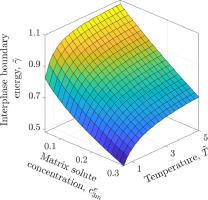当前位置:
X-MOL 学术
›
Acta Mater.
›
论文详情
Our official English website, www.x-mol.net, welcomes your feedback! (Note: you will need to create a separate account there.)
Interphase boundary segregation and precipitate coarsening resistance in ternary alloys: An analytic phase-field model describing chemical effects
Acta Materialia ( IF 9.4 ) Pub Date : 2020-09-01 , DOI: 10.1016/j.actamat.2020.06.052 Sourabh B Kadambi , Fadi Abdeljawad , Srikanth Patala
Acta Materialia ( IF 9.4 ) Pub Date : 2020-09-01 , DOI: 10.1016/j.actamat.2020.06.052 Sourabh B Kadambi , Fadi Abdeljawad , Srikanth Patala

|
Abstract Many experimental and first principles studies on precipitation hardening alloys show that segregation of elemental species to the matrix-precipitate interphase boundary (IB) reduces the boundary’s energy. This segregation mechanism can thermally stabilize the microstructure against precipitate coarsening processes and allow for higher operating temperatures in structural applications. In this paper, we develop a phase-field modeling framework to describe IB solute segregation in ternary alloys. The interfacial thermodynamics is effectively described by defining an IB phase with a characteristic free energy-concentration dependence. Equilibrium for the IB phase is established via the parallel tangent plane construction, analogous to classical treatments for segregation to free surfaces and grain boundaries. Analytic steady-steady solutions elucidating the dependence of IB properties on bulk phase composition, temperature and model parameters are derived for a one-dimensional system. Analytic relations for the classical thermodynamic quantities–IB energy and relative solute excess–are derived and the Gibbs adsorption equation is shown to hold; therefore, predictions of the model can be compared with experiments and atomistic simulations. An application of the model is demonstrated for Zn segregation to Mg/Mg2Sn using representative IB parameters. A two-particle coarsening simulation of IB segregation is performed: the result demonstrates enhanced coarsening resistance of the ternary alloy relative to the binary alloy.
中文翻译:

三元合金中的相界面偏析和抗析出粗化:描述化学效应的分析相场模型
摘要 许多关于沉淀硬化合金的实验和第一性原理研究表明,元素物质向基体-沉淀相界面 (IB) 的偏析降低了界面能量。这种偏析机制可以使微观结构热稳定以防止沉淀粗化过程,并允许在结构应用中实现更高的工作温度。在本文中,我们开发了一个相场建模框架来描述三元合金中的 IB 溶质偏析。通过定义具有特征自由能浓度依赖性的 IB 相,可以有效地描述界面热力学。IB 相的平衡是通过平行切平面构造建立的,类似于用于分离到自由表面和晶界的经典处理。为一维系统导出了解析稳态解,阐明了 IB 属性对体相组成、温度和模型参数的依赖性。推导出经典热力学量——IB 能量和相对溶质过量的解析关系,并显示吉布斯吸附方程成立;因此,模型的预测可以与实验和原子模拟进行比较。使用代表性 IB 参数演示了该模型的应用,用于将 Zn 偏析为 Mg/Mg2Sn。进行了 IB 偏析的两粒子粗化模拟:结果表明,三元合金相对于二元合金具有增强的抗粗化能力。温度和模型参数是为一维系统导出的。推导出经典热力学量——IB 能量和相对溶质过量的解析关系,并显示吉布斯吸附方程成立;因此,模型的预测可以与实验和原子模拟进行比较。使用代表性 IB 参数演示了该模型的应用,用于将 Zn 偏析为 Mg/Mg2Sn。进行了 IB 偏析的两粒子粗化模拟:结果表明,三元合金相对于二元合金具有增强的抗粗化能力。温度和模型参数是为一维系统导出的。推导出经典热力学量——IB 能量和相对溶质过量的解析关系,并显示吉布斯吸附方程成立;因此,模型的预测可以与实验和原子模拟进行比较。使用代表性 IB 参数演示了该模型的应用,用于将 Zn 偏析为 Mg/Mg2Sn。进行了 IB 偏析的两粒子粗化模拟:结果表明,三元合金相对于二元合金具有增强的抗粗化能力。该模型的预测可以与实验和原子模拟进行比较。使用代表性 IB 参数演示了该模型的应用,用于将 Zn 偏析为 Mg/Mg2Sn。进行了 IB 偏析的两粒子粗化模拟:结果表明,三元合金相对于二元合金具有增强的抗粗化能力。该模型的预测可以与实验和原子模拟进行比较。使用代表性 IB 参数演示了该模型的应用,用于将 Zn 偏析为 Mg/Mg2Sn。进行了 IB 偏析的两粒子粗化模拟:结果表明,三元合金相对于二元合金具有增强的抗粗化能力。
更新日期:2020-09-01
中文翻译:

三元合金中的相界面偏析和抗析出粗化:描述化学效应的分析相场模型
摘要 许多关于沉淀硬化合金的实验和第一性原理研究表明,元素物质向基体-沉淀相界面 (IB) 的偏析降低了界面能量。这种偏析机制可以使微观结构热稳定以防止沉淀粗化过程,并允许在结构应用中实现更高的工作温度。在本文中,我们开发了一个相场建模框架来描述三元合金中的 IB 溶质偏析。通过定义具有特征自由能浓度依赖性的 IB 相,可以有效地描述界面热力学。IB 相的平衡是通过平行切平面构造建立的,类似于用于分离到自由表面和晶界的经典处理。为一维系统导出了解析稳态解,阐明了 IB 属性对体相组成、温度和模型参数的依赖性。推导出经典热力学量——IB 能量和相对溶质过量的解析关系,并显示吉布斯吸附方程成立;因此,模型的预测可以与实验和原子模拟进行比较。使用代表性 IB 参数演示了该模型的应用,用于将 Zn 偏析为 Mg/Mg2Sn。进行了 IB 偏析的两粒子粗化模拟:结果表明,三元合金相对于二元合金具有增强的抗粗化能力。温度和模型参数是为一维系统导出的。推导出经典热力学量——IB 能量和相对溶质过量的解析关系,并显示吉布斯吸附方程成立;因此,模型的预测可以与实验和原子模拟进行比较。使用代表性 IB 参数演示了该模型的应用,用于将 Zn 偏析为 Mg/Mg2Sn。进行了 IB 偏析的两粒子粗化模拟:结果表明,三元合金相对于二元合金具有增强的抗粗化能力。温度和模型参数是为一维系统导出的。推导出经典热力学量——IB 能量和相对溶质过量的解析关系,并显示吉布斯吸附方程成立;因此,模型的预测可以与实验和原子模拟进行比较。使用代表性 IB 参数演示了该模型的应用,用于将 Zn 偏析为 Mg/Mg2Sn。进行了 IB 偏析的两粒子粗化模拟:结果表明,三元合金相对于二元合金具有增强的抗粗化能力。该模型的预测可以与实验和原子模拟进行比较。使用代表性 IB 参数演示了该模型的应用,用于将 Zn 偏析为 Mg/Mg2Sn。进行了 IB 偏析的两粒子粗化模拟:结果表明,三元合金相对于二元合金具有增强的抗粗化能力。该模型的预测可以与实验和原子模拟进行比较。使用代表性 IB 参数演示了该模型的应用,用于将 Zn 偏析为 Mg/Mg2Sn。进行了 IB 偏析的两粒子粗化模拟:结果表明,三元合金相对于二元合金具有增强的抗粗化能力。


























 京公网安备 11010802027423号
京公网安备 11010802027423号